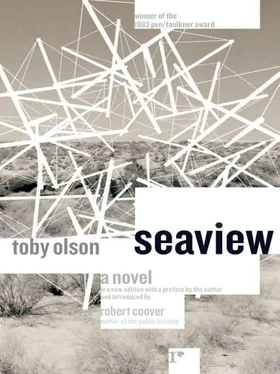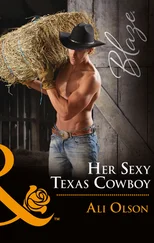“I think a three, can’t quite tell how far I am,” he said.
“Can’t help; don’t know how ya hit,” Frankie said. “There’s the one-fifty marker over there.” He lifted his chin in the direction of the other side of the fairway ahead of them, indicating a red stick at the edge of the rough.
Allen approached his ball and stood behind it, sighting down the row of trees, then he stepped up to it. When he hit it, he caught a little grass behind it, meeting it fat. It was low, along the line of trees, and straight.
“Trap,” Frankie said matter-of-factly behind him before the ball landed. It hit in the middle of the sand trap to the right of the green.
“Right,” he said, and he got back into the cart with Frankie.
Frankie was next. He hit a shot, again with a slight hook in it, that was high and stopped where it landed, on the green to the left of the flagstick, pin high, about twenty-five feet from the cup. Steve hit a seven-iron; the shot was as straight as his drive had been. It hit about ten yards short of the green and ran up to within six feet of the hole. The hot dog used a wedge, less club than he needed. He came through it smoothly and with considerable snap; it clicked off the club face, and a good-sized divot rose up a few feet in the air ahead of where it had rested. It was high and true. It landed to the back of the green, bit, and shot back about three feet, coming to rest on the high side of the hole, about twelve feet away, leaving him with a tricky downhill putt.
When they got to the green, all of them got out of the carts, and the three others waited for Allen to hit from the trap before they walked up onto the putting surface. The trap was wide and flat; good sand, he thought, and his ball sat up cleanly, a thin furrow in the sand running from the back of the trap, where the ball had hit, to where it now rested. He was about ten feet from the lip, which was low and would not come into play. There was about fifteen feet of green between him and the cup. The first five feet or so were level, and then the green sloped down a little. On the other side of the cup there was another thirty yards of level green and another ten feet of good apron before the slope down into the thicker rough. He hit the ball thin, lifting only a little sand, and the ball flew most of the green, hitting near the far edge, and trickled to the back of the apron and just over into the beginning of the rough. He looked up to the others and shrugged in an embarrassed way, then raked the trap and walked around their lines on the green to the far side. He had forgotten to get a club, had his sand wedge in his hand, and he trotted back to the cart to get one.
“Take your time,” Steve said, smiling for the first time.
He got three clubs out of his bag, a wedge, a seven-iron, and his putter, and crossed the green again. He looked the shot over, took a practice chip with his seven-iron, then dropped it beside the putter in the grass and selected the wedge. He did not want to mess with roll on this shot. He could see enough level green near the pin where he could lay it down. He had a good lie, and he decided not to bring the ball back at all. He lifted it carefully, quite high; it landed and rolled a few feet and came to rest five feet from the hole. Lou missed his putt and took a tap-in for a four. Frankie missed his also, had a tricky three-footer coming back, but knocked it in with some authority. Allen took a bogey five. Steve ran his into the heart of the cup for a birdie three. It was not until they got to the back nine that they began to gamble in earnest.
IT WAS HOT IN THE FOOTHILLS, BUT THE AIR WAS DRY. When he got to where the road ended abruptly beside a staked-out lot, he sat on a rock and took a sip of water from the small cough-syrup bottle he carried in his shirt pocket. From his back pocket he took out a piece of cloth and tied it around his forehead as a sweatband. While he was resting he checked the gunny sack for holes, and in the bottom of it he found an old golf cap with the words Redwood Links stenciled on a patch above the brim. He put it on, and his face felt cooler.
He had gotten a ride from two Indians in a pick-up truck who were headed over the foothills to their reservation. They had passed a few words, and they had let him out where the last of a series of dirt roads spurred off from the blacktop, heading deeper into the hills. When he got to the end of the road, where he rested, he was above all the development, though the two men had told him that that would not last and that the white men were planning more roads further up. After he’d rested he walked off into the wilds of the foothills, snaking back and forth though moving significant distance away from the developed land.
He stopped occasionally to listen and watch birds and to sip some drops from his bottle. Much of what he was walking through was sand, red clay, and shale, with low cactuses and occasional desert flowers growing here and there. He found four small arroyos where there was a little shade and greener growth, and he came upon two caves where he found what he took to be javelina spore, but it was not fresh and he did not see any javelinas.
He gave up his search for the javelinas after a while and sat down to think about the rattlers before hunting them. It was well into July, so it would be a little tricky, though not as bad as August. In August, the snake shed his skin; he was blind then, and he would strike out at anything that moved, without any kind of warning. He was a little skittery in July, so you would need a good stick. He found one about four feet long, broke the twigs off it, and waved it a little for feel. Then he began looking for the snakes.
He poked the stick around the bases of cactuses. When he came to places where the shale was a little elevated, he circled them, checking for sunny resting places. After about a half-hour, he found his first one. It was good size, about five feet long he guessed, and good and fat. It lay flat, strung out from tail rattles to a point about eight inches from its broad head, where there was a bend in it, a little slack it used when it raised up some to check things. Its head was flat on the rock, its eyes half open and a little glazed. The piece of red shale it was on was about two feet off the ground; it protruded in a shelf out from a configuration of shale that was about ten feet in diameter. He was standing off to the side of it. “Good afternoon,” he said to himself and moved slowly away and to the left to get a look at what was behind it.
Though the rock to the rear of the snake’s tail was in shade, it seemed darker than it should be there, and he suspected that there was an opening between rocks where the snake, if he startled it, could go. He would not want to mess with it if it got in there. He moved slowly, a little more to his left, aiming to come close to getting between the sun and the snake. When he had moved far enough back and to the side, he was about thirty feet from the snake, a little to the left of its head. He raised both of his hands, linking his fingers together, and moved them slowly into the path of the sun. He was humming softly, a kind of cricket whistle, disjointed and without any clear rhythm. When his hands got in the sun’s way, they threw a shadow on the ground about six feet from the overhang on which the snake rested.
He altered his fingers slightly, forming the shape of a small rodent on the ground. He tested it by rippling his fingers slightly; the shadow undulated like some injured thing. He bent quickly to the left, his hands still in the air, and then moved back again. For a moment he had thrown a shadow across the snake’s head. The snake’s head lifted in a quick fluid gesture, its eyes snapping open. For a full two minutes, it looked slowly around, shifting its body slightly. Then it lowered its head to the same place on the rock, but its eyes remained open.
Читать дальше












